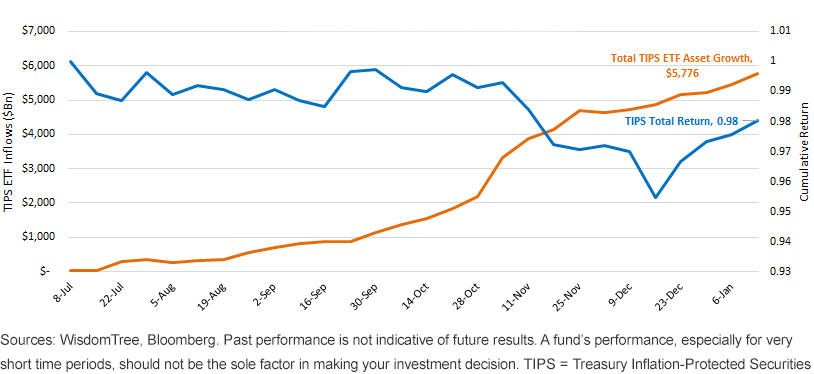One of the hallmarks of the newly inaugurated U.S. president’s administration is a focus on infrastructure spending. But the U.S. is not alone as a centerpiece in the global economy in its fiscal thrust. We are also getting a fiscal push from Asia. Last year, Japan embarked on a fiscal expansion program that would span four to five years and put 27 trillion yen to work. China also turned on the fiscal spigots, and we saw companies that supply construction equipment to China take a meaningful turn higher in their share prices.
Due to tightness in the U.S. labor markets, a number of investors are worried we will see inflation pressures. We have seen a surge of inflows toward U.S. inflation-protected bonds in the last six months as a result of these macro drivers.
inflation-protected bonds Exchange-Traded Fund (ETF) Inflows vs. TIPS Performance (1/8/16–1/13/17)
The return on Treasury Inflation-Protected Securities (TIPS) over the last six months, despite the inflows, has been subpar, to put it mildly—though perhaps a better description is “disappointing.” These bonds have seen negative returns because in addition to increasing expectations for inflation, there was also a move higher in “real” interest rates. This caused losses on bond funds tracking these indexes. And despite the move higher in rates, the 10-Year real bond yield is still just .40%, well below longer-run averages.1
Commodities as an Alternative Inflation Hedge
If investors are flocking to TIPS for inflation protection, what are some alternative approaches that might help protect a portfolio? A principal reason investors allocate to commodities is to hedge inflation over time.
Commodities can be quite volatile, even when traded as a diversified basket, and the last five to seven years they have been one of the worst-performing asset classes, alongside emerging market equities.














Leave A Comment